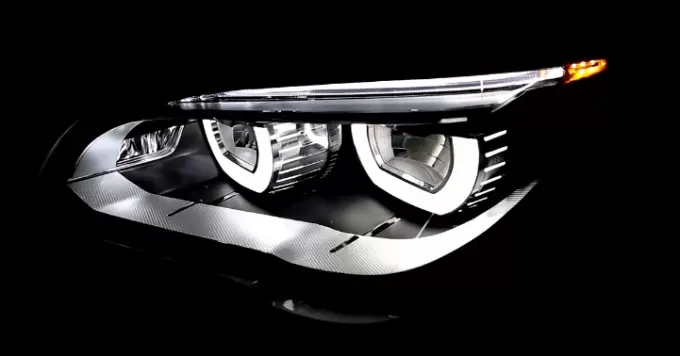This new technology is an extension of the self-levelling headlights that you can find on most modern cars. These kinds of headlights contain a sensor that.jpg) determines when our vehicle is going over a bump in the road. When you drive over a speed bump, for example, the front end of your car is angled up as you go over it, then down as you pass the bump. Self-levelling headlights adjust to compensate for this change in angle. When the front of your car is pointing up, self-levelling lights point downwards to continue illuminating the road. Not only does this help you see better, it prevents your headlights from flashing in the eyes other drivers.
determines when our vehicle is going over a bump in the road. When you drive over a speed bump, for example, the front end of your car is angled up as you go over it, then down as you pass the bump. Self-levelling headlights adjust to compensate for this change in angle. When the front of your car is pointing up, self-levelling lights point downwards to continue illuminating the road. Not only does this help you see better, it prevents your headlights from flashing in the eyes other drivers.
In Europe, all new cars are required to have self-levelling headlights. In the United States, they're only mandatory in cars with xenon HID headlights. Self-levelling headlights are especially important in cars with brighter headlights, such as HID. This is because they run a greater risk of dazzling oncoming drivers when going over bumps.
Adaptive headlights
Adaptive headlights are even more advanced. Self-levelling can only adjust up or down, but adaptive can move from side to side. This is helpful when driving on a winding road, for example. If you come to a point where the road curves left and you begin to turn left, standard headlights will remain pointing forward. This means that your headlights, no matter how bright they may be, are illuminating the side of the road. Adaptive headlights, on the other hand, will turn left along with you, brightening up the road ahead where you need it the most.
How does this work? Adaptive headlights are connected to electronic sensors in the car. These sensors monitor the speed of the vehicle, the direction of the steering wheel, and the side-to-side motion of the car. With all this information, the sensors can tell which way you're going, and how your vehicle is  angled. They can then determine exactly where your headlights should be pointing. The sensors are connected to small electric motors inside each headlight casing. They work by turning the headlights accordingly.
angled. They can then determine exactly where your headlights should be pointing. The sensors are connected to small electric motors inside each headlight casing. They work by turning the headlights accordingly.
The headlights are also clever enough to know when not to move. If your car is stationary, moving very slowly, or in reverse, the adaptive headlights won't kick in. This helps to prevent these kinds of headlights from moving too much and causing glare or distractions when not necessary.
Limitations
Adaptive headlights are still a relatively new technology, and they have a limited range of motion. Most can only turn 15 degrees to either side, so they may not adapt well to sharp turns. As more companies seek to add adaptive headlights to their new vehicles, we may see improvements in this area.
If you're looking for a car with adaptive headlights, you'll need to have a big budget - they're generally only available on luxury cars. Even then, they're not a standard feature, so expect to pay extra for this technology.

The new standard
In the future, we can expect to see more cars with adaptive headlights. Just as self-levelling headlights are becoming a standard feature around the world, adaptive headlights will someday become the new standard. They offer tremendous safety benefits. Drivers with adaptive headlights can see much more clearly and avoid obstacles they might have otherwise noticed too late. For other motorists, adaptive headlights are less likely to cause glare and blind drivers.
In the meantime, if you can afford a vehicle with adaptive headlights, it's a good investment. They'll make nighttime driving much easier and safer, and you can be assured that you're taking advantage of cutting edge headlight technology.
Shop car bulbs here.












_620_210.png)













 Close
Close